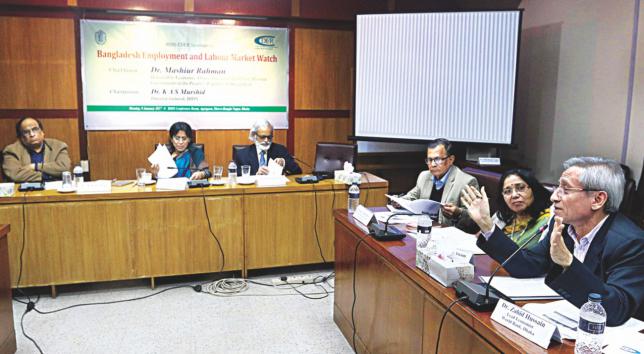Published in The Daily Star on Tuesday, 10 January 2017
One-fourth of youth population falling behind: study
Centre for Development and Employment Research starts journey
Star Business Report

One-fourth, or 11 million, of the country’s 43.43 million youth population is neither in education nor in the labour force — a concerning number as the society is deprived of their contribution.
Males outnumber females in this group, said Rushidan Islam Rahman, executive chairperson of the Centre for Development and Employment Research (CDER), at a seminar yesterday.
CDER formally launched its activities through the event, which it jointly organised with the Bangladesh Institute of Development Studies.
The numbers imply that a huge chunk of the youth population is unutilised, she said at the seminar — Bangladesh Employment and Labour Market Watch, 2017.
The number of youth population aged between 15 and 29 years rose to 43.43 million in 2013 from 39.25 million in 2010, Rahman said.
The number of youth labour force increased to 23.35 million in 2013 from 20.90 million three years ago, implying the positive growth of potential demographic dividend.
However, labour force participation rose slightly among youths, with participation among males falling while female increasing.
Apart from the absence of one-fourth of the country’s youth in the labour force, high unemployment among graduates and postgraduates also raises concerns and questions about the quality of education offered by the universities.
The unemployment rate among graduates and above increased to 16.4 percent in 2013 from 9.9 percent in 2010, Rahman added.
“We were always told that those who study ride in cars,” said Debapriya Bhattacharya, distinguished fellow of the Centre for Policy Dialogue.
But that saying no longer holds true given the high unemployment rate among educated youths. “It is very worrying,” he added. Youth unemployment is like a time bomb, said Shaheen Anam, executive director of Manusher Jonno Foundation.
“It is sad that people are desperately looking for jobs but employers say that they do not get quality human resources.” The existing education system does not match the requirements of the market.
The state should frame policies conducive to employment generation; it must ensure good governance to facilitate employment, Anam added.
“This is a paradoxical situation because the education sector is not able to meet the demand,” said Zahid Hussain, lead economist of the World Bank’s Dhaka office, adding that employers do not get the skills that they are seeking out. The employment challenge is daunting as nearly two lakh people join the workforce every year, he said, while calling for free movement of labour globally just like free trade and free flow of capital.
CPD Executive Director Mustafizur Rahman suggested public-private partnership to develop skilled workforce for the industries. He also stressed movement of labour under the World Trade Organisation agreements.
“We also do not have employment mapping like poverty mapping. It should be done,” he added. Rizwanul Islam, senior visiting fellow of CDER, stressed the importance of good quality data for monitoring purposes.
For instance, he cited the decline in employment growth (from 3.3 percent in 2006-10 to 2.4 percent in 2010-13), the jump in labour productivity growth in 2010-13 from the previous eight years and the steep decline in the incidence of poverty among some categories of employed people.
“The above is not consistent with the decline in real wages from 2011-12 through 2014-15.” Bangladesh needs to register 8 percent growth a year to fully utilise its surplus labour within the next 15 years, he added.
Abdul Bayes, director of research and evaluation division of Brac, also spoke, among others.

